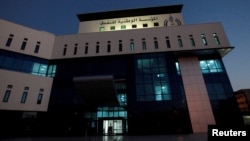Libya’s oil exports are at a near standstill as political tensions flare over the control of the nation’s central bank, the key institution managing the nation’s oil revenues. Only a few ships have been allowed to load crude from existing stocks.
While a recent agreement between rival governments in Libya’s east and west have raised hopes for a return to normal, industry analysts say the situation remains unsettled and it is unclear when production might resume.
Forces aligned with eastern leader Khalifa Haftar halted production at major oil fields and terminals on August 26, slashing output by half.
The disruptions, particularly in exports to Europe, have sent ripples through global energy markets and left energy workers, investors and international businesses on edge.
Not for the first time this year, the National Oil Corporation has declared force majeure, seeking release from its contractual obligations because of events beyond its control.
The NOC previously halted production at its Sharara oilfield on January 7 because of protests, which suspended crude supplies to the Zawiya terminal. Two weeks later, the force majeure was lifted, and full production resumed.
'Sudden and surprising'
The International Crisis Group’s senior analyst for Libya, Claudia Gazzini, who has also served as a special representative and head of the U.N. Support Mission in Libya, told VOA that the latest disruption in Libya’s oil production came unexpectedly.
"These developments were rather sudden and surprising, especially since there had been relative peace on the ground," Gazzini said. She noted that for nearly two years, a deal had been in place in which various factions agreed to continue exporting and producing oil in exchange for a share of the revenues.
According to Gazzini, oil-producing areas in Libya are primarily under the control of the forces backed by Haftar in the east, while the revenues are distributed by the Central Bank of Libya, which is controlled by the rival government based in Tripoli.
“There was an understanding, even among foreign partners, that this deal would hold, based on the belief that both sides would benefit from the oil revenues, which was the foundation of the agreement. We weren't expecting the system in place to collapse so abruptly or for this feud over the central bank to erupt,” Gazzini said.
She added, “We don’t know when the feud over control of the central bank will be resolved."
She said the crisis was precipitated when the presidential council in Tripoli fired the bank governor on August 19. The Haftar-backed factions and parliament, which supported the ousted governor, retaliated by shutting down oil production.
“We don’t expect a quick resolution to this dispute, and these disruptions could persist for a longer period,” she warned.
The political standoff cut Libya’s oil production significantly, causing world oil prices to briefly rise above $80 per barrel for Brent crude before settling back.
A recent agreement between Libya’s legislative chambers has sparked hope that production and exports might soon return to normal, but challenges remain.
Kevin Morrison, an energy finance analyst at the Institute for Energy Economics and Financial Analysis (IEEFA) in Sydney, told VOA that the potential resolution between rival factions in Libya and the subsequent restoration of crude oil production come at a critical time.
OPEC members are now realizing that China’s oil demand may not be as strong as previously anticipated, said Morrison, who works closely with the global oil and gas team at the IEEFA.
Morrison attributed the decline in Chinese demand not only to a weaker economy but also to the rapid transition to electric vehicles, which has reduced oil consumption in the world’s second-largest economy and largest energy consumer.
Ninety-eight percent of Libya’s government income and 65% of its GDP come from oil. At more than 1.2 million barrels per day, Libya ranks as Africa’s leading oil producer and among the top oil-producing nations globally.






